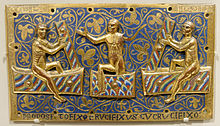
Back Auferstehung ALS البعث بعد الموت Arabic Resurreición AST Възкресение Bulgarian Dasorc'hidigezh Breton Resurrecció Catalan Vzkříšení Czech Opstandelse Danish Reviviĝo Esperanto Resurrección Spanish



Resurrection or anastasis is the concept of coming back to life after death. In a number of religions, a dying-and-rising god is a deity which dies and is resurrected. Reincarnation is a similar process hypothesized by other religions, which involves the same person or deity coming back to another body. Disappearance of a body is another similar, but distinct, belief in some religions.
With the advent of written records, the earliest known recurrent theme of resurrection was in Egyptian and Canaanite religions, which had cults of dying-and-rising gods such as Osiris and Baal. Ancient Greek religion generally emphasised immortality, but in the mythos a number of men and women were made physically immortal as they were resurrected from the dead.
The universal resurrection of the dead at the end of the world is a standard eschatological belief in the Abrahamic religions. As a religious concept, resurrection is used in two distinct respects:
1) a belief in the individual resurrections of individual souls that is current and ongoing (Christian idealism, realized eschatology),
2) a general bodily universal resurrection of all of the dead at the end of the world.[1] Some believe the soul is the actual vehicle by which people are resurrected.[2]
The death and resurrection of Jesus is a central focus of Christianity. While most Christians believe Jesus' resurrection from the dead and ascension to heaven was in a material body, some believe it was spiritual.[3][4][5]
Like the Abrahamic religions, the Dharmic religions also include belief in resurrection and reincarnation. There are stories in Buddhism where the power of resurrection was allegedly demonstrated in Chan or Zen tradition. In Hinduism, the core belief in resurrection/reincarnation is known as saṃsāra.[6]
Aside from religious belief, cryonics and other speculative resurrection technologies are practiced, but the resurrection of long-dead bodies is not considered possible at the current level of scientific knowledge.
- ^ In the language of the Christian creeds and professions of faith this return to life is called resurrection of the body (resurrectio carnis, resurrectio mortuoram, anastasis ton nekron) for a double reason: first, since the soul cannot die, it cannot be said to return to life; second the heretical contention of Hymeneus and Philitus that the Scriptures denote by resurrection not the return to life of the body, but the rising of the soul from the death of sin to the life of grace, must be excluded."
- ^ "Gregory of Nyssa: "On the Soul and the Resurrection:" However far from each other their natural propensity and their inherent forces of repulsion urge them, and debar each from mingling with its opposite, none the less will the soul be near each by its power of recognition, and will persistently cling to the familiar atoms, until their concourse after this division again takes place in the same way, for that fresh formation of the dissolved body which will properly be, and be called, resurrection". Ccel.org.
- ^ Symes, R. C. "According to Paul of Tarsus, the resurrection transformed Jesus into the Christ, the Son of God and Savior of the world. Christ's resurrected body was not a resuscitated physical body, but a new body of a spiritual/celestial nature: the natural body comes first and then the spiritual body (1 Cor. 15:46). Paul never says that the earthly body becomes immortal". religioustolerance.org.
- ^ The Watchtower Society claims that Jesus was not raised in His actual physical human body, but rather was raised as an invisible spirit being—what He was before, the archangel Michael. They believe that Christ's post-Resurrection appearances on earth were on-the-spot manifestations and materializations of flesh and bones, with different forms, that the Apostles did not immediately recognize. Their explanation for the statement "a spirit hath not flesh and bones" is that Christ was saying that he was not a ghostly apparition, but a true materialization in flesh, to be seen and touched, as proof that he was actually raised. But that, in fact, the risen Christ was, in actuality, a divine spirit being, who made himself visible and invisible at will. The Christian Congregation of Jehovah's Witnesses believes that Christ's perfect manhood was forever sacrificed at Calvary, and that it was not actually taken back. They state: "...in his resurrection he ‘became a life-giving spirit.’ That was why for most of the time he was invisible to his faithful apostles... He needs no human body any longer... The human body of flesh, which Jesus Christ laid down forever as a ransom sacrifice, was disposed of by God's power."—Things in Which it is Impossible for God to Lie, pages 332, 354.
- ^ "Resurrection Theories". Gospel-mysteries.net. Retrieved 4 May 2013.
- ^ "What does Hinduism teach about life after death? - Life after death - GCSE Religious Studies Revision".
© MMXXIII Rich X Search. We shall prevail. All rights reserved. Rich X Search